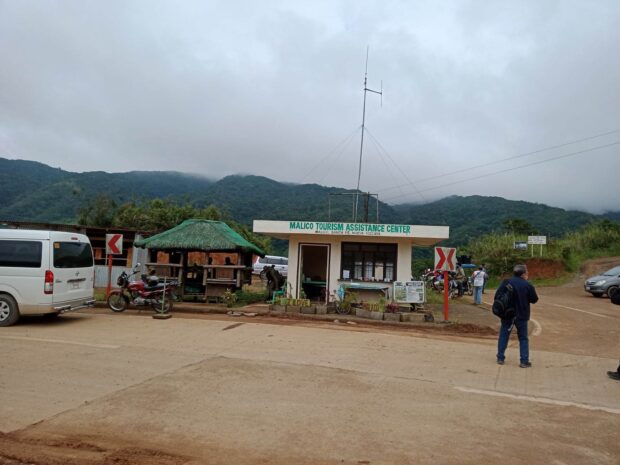
Local officials of San Nicolas town, Pangasinan province question the construction of this tourism center, which they said is located within the town’s territory. The building was put up by the local government of Sta. Fe, Nueva Vizcaya, which is also claiming the area. (Photo by Yolanda Sotelo)
LINGAYEN, Pangasinan — The Pangasinan provincial board declared the upland village of Malico in San Nicolas town as the “Barangay Summer Capital of Pangasinan.”
The declaration was made on Monday, March 20, during the board’s first out-of-town session held at the village gymnasium.
Board Member Noel Bince said during the session that the declaration would “strengthen the position and consolidate and reinforce the claim of barangay Malico as a territory of Pangasinan.”
The province of Nueva Vizcaya has been claiming the village as part of its territory, but the Indigenous People, who had been long-time Malico residents, said the village had historically been a part of Pangasinan, and that they were registered as voters in San Nicolas.
The mountain village is home to less than 200 indigenous families that belong to the Kalanguya Tribe.
Nestled 1,675 meters above sea level (masl), which is higher than Baguio City’s 1,470 masl, Malico has a cold and foggy climate with a relatively unspoiled environment.
Its land area is just a fourth of Baguio’s and is mostly covered with pine forest.
It also boasts a historical value, although a bloody one.
It was used as a military base of the Japanese Imperial Army during World War 2, and battles from February to June 1945 led to the death or injury of 4,600 Japanese soldiers, 3,200 American soldiers, and countless Filipino residents. A memorial for them was erected at the Salacsac Pass.
Historical value
It could be because of its picturesque, “Instagram-able” environment and historical value that Nueva Vizcaya wants the village for itself, local officials said. But Pangasinan refused to give it up.
Bince said the municipal council of San Nicolas “earnestly requested” the provincial board to declare the village the barangay summer capital of Pangasinan through Resolution 88-2020 two years ago.
The measure was approved after it was co-authored by all board members, including Vice Governor Mark Lambino, who presided over the board session.
‘Strong objection’
During the same session, the provincial board also declared its support for San Nicolas’ resolution (164-2021) registering a “strong objection to the unauthorized construction of a Malico tourism outpost and the collection of tourism fees within the territory of Malico, San Nicolas,” by Sta. Fe, Nueva Vizcaya.
The resolution, read by Bince, said, “San Nicolas expresses its concern over the unauthorized construction of a Sta. Fe tourism outpost and the collection of fees in tourism spots, in locations identified [as] the territorial jurisdiction of Malico, San Nicolas, since time immemorial.”
The provincial board also discussed the concern of San Nicolas about the completion of the Malico access road, with a project cost of P3 million from the National Task Force to End Local Communist Armed Conflict.
In a letter to Pangasinan Gov. Ramon Guico III, San Nicolas Mayor Primicias-Enriquez asked for legal advice and recommendations on whether the Nueva Vizcaya provincial board has the authority to suspend a government project or order the other province with which it has a territorial dispute, to cease from implementing development projects.
Lambino endorsed the request to the Provincial Legal Office to study the legality of the matter.
Indigenous Peoples representation
During the session, the Kalanguya tribe members, who are residents of Malico, asked the provincial board to allow the representation of IPs and Indigenous Cultural Communities (ICC) on the provincial board and municipal council in towns where there are IPs.
Tribal leader Danilo Bontog said it was the “humble aspiration of tribes in Sison and other towns, (and) we are (asking) the [provincial board] and executive leadership to allow representation IPP ICCs to seat in the legislative body as provided by law.”
He said there are three ethnic tribes in San Nicolas: Kalanguya in Malico, Iwak in Fianza, and Ibaloi in Kabayawasan.
Belen Segundo, 97, fiddles with a “pakgong,” a traditional musical instrument of the Kalanguya tribe, during the 25th Jubilee of Indigenous Peoples’ Rights Act of 1997, in October 19, 2022. Seated beside Segundo is Menesia Pilyan, 77, also a Kalanguya tribe member. Both are residents of Sta. Rosa, a barangay that used to be sitio Salacsac of Barangay Malico. Photo courtesy of Ray Zambrano
“Section 16 of [Republic Act] 8371, or the Indigenous People’s Rights Act of 1997, mandates a representative of IP in all levels of decision-making where there are IPs and ICCs following the traditional processes of choosing their representatives,” Bontog said.
In the entire Pangasinan, 18,363 members of IP communities, and two towns—San Nicolas and Sison—have representatives in the town councils.
Some 15,000 hectares in the two towns have been awarded certificates of the ancestral domain by the Commission on Indigenous People, Bontog said. INQ
RELATED STORIES
Malico: The focus of my Personal Social Responsibility journey
Pangasinan execs vow to keep village amid border dispute with N …